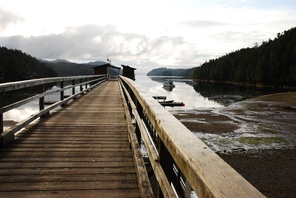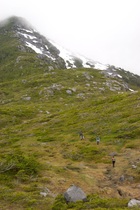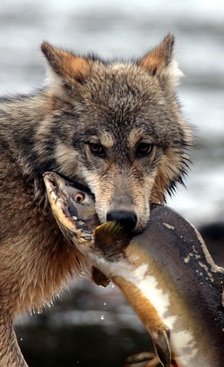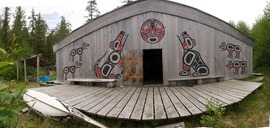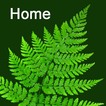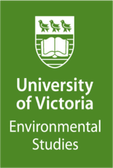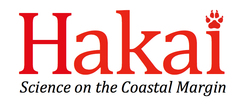Research on the Central Coast
The Central Coast of BC is home to research on a wide range of topics. Below you will find some of the researchers who work on biodiversity-related topics in the area, as well as some group initiatives and projects.
|
Research at the Hakai Institute The Hakai Institute conducts a variety of interdisciplinary research programs based out of its Calvert Island field station. Most of these programs have a biodiversity element to them; the 100 Islands Project and the Changing Seascapes Program are particularly focused on biodiversity. |
|
The Starzomski Lab at the University of Victoria
Led by Dr. Brian Starzomski, "we conduct research in community ecology, restoration ecology, and conservation biology in the School of Environmental Studies at the University of Victoria. Broadly, this research takes three forms, but focuses on the determinants of local diversity in light of climate change." Also check out the Climate and Biodiversity topic found under Terrestrial Research at the Hakai Institute, as well as the Starzomski Lab Tumblr page. |
The John Reynolds Research Group at Simon Fraser University
Led by Dr. John Reynolds, "we combine research and education aimed at enhancing aquatic biodiversity, including large-scale field studies of salmon and their ecosystems. Our projects range from impacts of nutrients from salmon on birds and plants to links between life history traits of fish and vulnerability to extinction."
Dr. Nancy Turner "Distinguished Professor and Hakai Professor in Ethnoecology, Nancy Turner is an ethnobotanist whose research integrates the fields of botany and ecology with anthropology, geography and linguistics, among others. She is interested in the traditional knowledge systems and traditional land and resource management systems of Indigenous Peoples, particularly in western Canada."
Led by Dr. John Reynolds, "we combine research and education aimed at enhancing aquatic biodiversity, including large-scale field studies of salmon and their ecosystems. Our projects range from impacts of nutrients from salmon on birds and plants to links between life history traits of fish and vulnerability to extinction."
Dr. Nancy Turner "Distinguished Professor and Hakai Professor in Ethnoecology, Nancy Turner is an ethnobotanist whose research integrates the fields of botany and ecology with anthropology, geography and linguistics, among others. She is interested in the traditional knowledge systems and traditional land and resource management systems of Indigenous Peoples, particularly in western Canada."
|
The Applied Conservation Lab
at the University of Victoria Led by Dr. Chris Darimont, "we are a team of multidisciplinary conservation scholars dedicated to conceptually interesting and acutely applied research for the benefit of natural and human systems. A special geographic focus is the Great Bear Rainforest on British Columbia’s central coast." Dr. Tom Reimchen's Lab at the University of Victoria Dr. Reimchen's lab focuses on evolutionary and ecological studies, largely based on the BC coast. Ongoing projects include the Salmon Forest Project, which examines the complex connections between marine and terrestrial systems through the transfer of nutrients via Pacific salmon and coastal grizzly and black bears. |
|
Coastwatch Heiltsuk Monitoring
and Stewardship "Coastwatch is a Heiltsuk-driven scientific research initiative that provides Heiltsuk people with the skills and knowledge to be proactive in resource management and conservation planning in our traditional territory." Coastwatch is part of the Qqs Projects Society. |
Qqs Projects Society "We are a registered nonprofit society established by and for the people of the Heiltsuk First Nation. We are based in Bella Bella on the remote Central Coast of British Columbia, in the heart of the Great Bear Rainforest."
Raincoast Conservation Foundation
"Raincoast is a team of conservationists and scientists empowered by our research to protect the lands, waters and wildlife of coastal British Columbia. We use rigorous, peer-reviewed science and grassroots activism to further our conservation objectives. We call this approach ‘informed advocacy’ and it is unique amongst conservation efforts."
"Raincoast is a team of conservationists and scientists empowered by our research to protect the lands, waters and wildlife of coastal British Columbia. We use rigorous, peer-reviewed science and grassroots activism to further our conservation objectives. We call this approach ‘informed advocacy’ and it is unique amongst conservation efforts."
Pacific Wild
Pacific Wild is committed to protecting the BC coast's wildlife and their habitat. It "supports innovative research, public education, community outreach and awareness to achieve the goal of lasting environmental protection in the lands and waters of the Great Bear Rainforest."
Pacific Wild is committed to protecting the BC coast's wildlife and their habitat. It "supports innovative research, public education, community outreach and awareness to achieve the goal of lasting environmental protection in the lands and waters of the Great Bear Rainforest."
The Coastal Marine Ecology and Conservation Lab at Simon Fraser University
Led by Dr. Anne Salomon, this lab conducts coastal research in two broad categories. The first focus is cascading effects of predator depletion and recovery: "examining predatory fish recovery in marine reserves, sea otter range expansion along British Columbia’s (BC) Central Coast, and the degree to which trophic cascades can cross ecosystem boundaries." The second focus is coupled human-ocean ecosystems: "by studying prehistoric clam gardens, contemporary Pacific herring declines, and community-based marine use plans in BC, my students and I aim to gain insights into the complex dynamics of these linked systems of people and nature."
Led by Dr. Anne Salomon, this lab conducts coastal research in two broad categories. The first focus is cascading effects of predator depletion and recovery: "examining predatory fish recovery in marine reserves, sea otter range expansion along British Columbia’s (BC) Central Coast, and the degree to which trophic cascades can cross ecosystem boundaries." The second focus is coupled human-ocean ecosystems: "by studying prehistoric clam gardens, contemporary Pacific herring declines, and community-based marine use plans in BC, my students and I aim to gain insights into the complex dynamics of these linked systems of people and nature."
